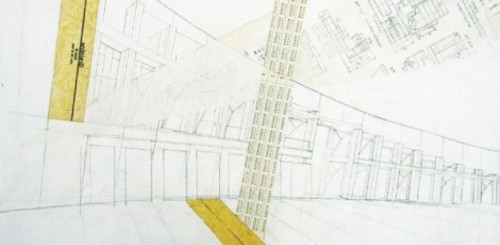Angels in the Architecture
Artists take on a thematic challenge to combine the ethereal with the concrete.
By Brian Staker @stakerizedIn 2008, Bills curated an exhibit at Art Access Gallery using images gathered along U.S. Highway 89, which runs from the top to the bottom of Utah, so he’s no stranger to wide-reaching themes. But the idea of unseen, ethereal presences—combined with the solid manifestations of architecture in our world—is a more challenging theme than most. “It was inspired when I saw one of Marcee Blackerby’s plates at the 2007 plates show at Art Access,” he recalls. Her multimedia piece, which had an angel emerging from a window, reminded him of the lyrics and inspired the show’s concept.
“Angels and architecture are central recurring motifs throughout Western art history,” Bills notes. “When you add the pop/contemporary origin of the theme, it provides a rich tableaux of centuries of Western culture to explore.” And explore it they did, through a number of media and perspectives.
Justin Wheatley—whose work had appeared in the Highway 89 show—combined his mixed-media works with his wife Camille’s drawings and photographs. “We immediately thought of personal spiritual experiences we have had that were brought on solely by the spaces where we stood,” he says. “In both cases, we stood surrounded by walls made from the simplest of materials, lit by natural light and echoing only the sounds we made. Our work focuses on the simplicity that created those experiences for us.”
Blackerby created new works for the show. Two of them are her customary 3-D mixed-media works from found materials like neckties, but several were two-dimensional collages made from vintage images and overlays of transparent images. “I liked the transparent idea since angels are a kind of ‘see-through’ and nebulous subject, and architecture suggests a solid and very earthbound thing,” she explains. She hopes her work will serve as a keystone to the other artists and their ideas.
Ideas definitely are not in short supply for this show, perhaps because of the loosely suggestive conceptual basis. Steven Stradley’s interactive exhibit is perhaps the most ambitious work here, as it reaches out to connect with the audience. “The work that I am including will allow people to customize their own angels as an added component to the whole work,” he explains. “I hope to achieve an investigation of others’ concepts of the angel and the interaction that these angels have within the space.”
Is it possible to respond to the theme without bringing a lot of spiritual baggage? Printmaker Joey Behrens, whose works are highly influenced by architectural drawings and city plans, sees the phrase “angels in the architecture” as referencing the character of a place. “Not being religious, for me the idea of angels is really a reference more to ‘the other,’ to mystery and myth,” she explains. “My work is very much about a sense of place. It’s about connecting to the city, the spaces I move through, connecting to the other people who make up this place, who infuse the city with its life and energy, and are infused by it.”
Linnie Brown’s work on paper panels is directly tied to place: “Last year, I learned that the junior high I had attended in Hillsboro, Oregon, would be demolished,” she recalls. “I was surprised how strongly the news affected me. We connect many feelings and memories to physical places and it’s unsettling to lose those places.” Architecture takes on the body of history in works like these, housing recollections in the form of traces or “angels” of experiences, yet unable to fully contain them.
The concept doesn’t seem static, but rather a catalyst to create something deep inside the viewer. “I wanted to take the icon of the angel and use it in a way that would capitalize on the stereotyped angel or would become something else, maybe something post-modern in nature,” Stradley says.
“I think we’ll barely scratch the surface of potential interpretations,” Bills surmises of the dozen artists featured. “The viewers will be introduced to such a wide variety of interpretations, and hopefully it will get them thinking about those ideas and maybe coming up with some interpretations of their own.”
ANGELS IN THE ARCHITECTURE
Art Access Gallery
230 S. 500 West #125
801-328-0703
Through May 13
AccessArt.org
More by Brian Staker
-
Live Music Picks: April 12-18
Judas Priest, The Residents, Clownvis Presley, The Breeders and more.
- Apr 11, 2018
-
Loving the Alienation
Helios Creed and Chrome continue making iconoclastic music for outcasts.
- Mar 28, 2018
-
Live Music Picks: March 22-28
U.S. Girls, Ed Schrader’s Music Beat, Hell’s Belles, Columbia Jones and more.
- Mar 21, 2018
- More »



